Acacia tetanophylla facts for kids
Quick facts for kids Acacia tetanophylla |
|
|---|---|
| Scientific classification | |
| Genus: |
Acacia
|
| Species: |
tetanophylla
|
 |
|
| Occurrence data from AVH | |
Acacia tetanophylla is a type of shrub, also known as a Wattle tree. It belongs to the Acacia family. This plant is special because it only grows naturally in one specific area: the southwestern part of Australia. When a plant or animal only lives in one place, it's called endemic.
Contents
About the Acacia Tetanophylla Plant
This interesting shrub usually grows to be about 0.6 to 2 meters (2 to 7 feet) tall. Its small branches can be either a bit hairy or completely smooth.
Leaves and Flowers
Like many Wattle plants, Acacia tetanophylla doesn't have regular leaves. Instead, it has what are called phyllodes. These are flattened leaf stems that look and act like leaves.
- The phyllodes are stiff and a grey-green color.
- They usually grow straight up and look like thin threads.
- When they are young, they have a cool six-sided shape.
- These smooth phyllodes are about 15 to 40 millimeters long and 1 to 1.5 millimeters wide.
- You can see seven small lines, or "nerves," on them.
This plant blooms, or flowers, from August to October. It produces bright yellow flowers. These flowers grow in simple, round clusters called inflorescences. Each flower cluster is about 3.5 to 4 millimeters wide and holds 13 to 18 golden-colored flowers.
Seed Pods and Seeds
After the flowers bloom, the plant forms seed pods. These pods are firm and feel like paper. They are smooth and usually long and narrow, growing up to 4 centimeters (1.6 inches) long and 2 to 4 millimeters wide. Inside these pods, you'll find shiny dark brown to black seeds. The seeds are shaped like an oval or egg and are about 2.5 to 3 millimeters long.
How Acacia Tetanophylla Was Named
The botanist Bruce Maslin was the first to officially describe this plant. He did this in 1977 as part of his work on the Acacia genus. His findings were published in a scientific journal called Nuytsia. Later, in 2003, another botanist named Leslie Pedley reclassified it. However, in 2006, it was moved back to the Acacia genus, where it remains today.
Where Acacia Tetanophylla Grows
This plant is found naturally in several regions of Western Australia. These areas include the Great Southern, Goldfields-Esperance, and Wheatbelt regions.
It often grows on flat plains near creeks and rivers. You can find it in different types of soil, such as:
- Rocky soil
- Sandy loam (a mix of sand, silt, and clay)
- Sandy-clay soil
- Sandy soil
Sometimes, it grows on or around large granite rocks. Its natural range stretches from just south of the Stirling Range in the northwest all the way to Ravensthorpe in the southeast. You can also find some plants in areas further north, like near Nyabing and Lake King.
See Also
- List of Acacia species

